Wireless Network and Communications 2nd Module
Wireless body area Network
WBAN can be considered as a special type of sensor network with its own specific requirements. WBAN consisits of a set of mobile and compact intercommunicating sensors.
Properties

Some of the unique properties of WBANs are as follows:
1.Due to the network's porximity to the human body,electromagnetic pollution should be extremely low. So a non-invasive WBAN requires that every node transmits at an extremely low power
A very suitable technology for the "non invasive" WBAN is the new and emerging ultra wide band(UWB)
2. Energy efficiency- The devices used have limited energy resources available as they are very small.It is difficult to frequently change the batteries in the sensors that are implanted in the human body of WBAN; therefore a long batterly lifetime is required
3.Multihop communication (comunicating indirectly through several intermediate nodes) is used to avoid the transmission to a far node with less power
4. Optium node density (number of active nodes in a network to provide better connectivity) is required for delivering the maximum number of data packets.
5. Efficient and cost- effective WBAN solutions are necessary to gain the pouplarity of WBAN
6.Simplex node-Usually node communication is simplex in nature that is they can only sense and transmit to other nodes that have high computational capabilities.
7.Proximity-Propagation of the waves take place in or on a very lossy medium like the human body and so the waves are attenuated considerably before they reach the receiver. Therefore a simple but accurate propagation model is wanted
8. Heterogeneous nodes- Devices are quite heterogeneous and may have very different demands or may require different resources of the netwok in terms of data rates,power consumption and reliability.
Network Architecture
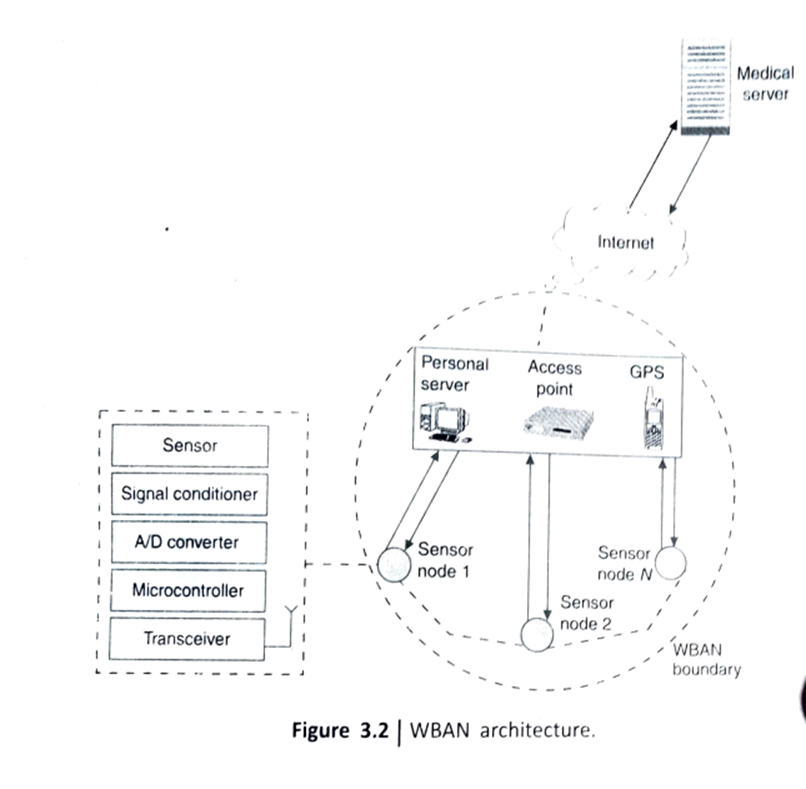
A three-tier network architecture for WBAN for health monitoring is shown in fig. Tier 1 consists of several sensor nodes where each node comprises sensor for capturing data, signal conditioner to shape the captured signal along to digital converter to convert the captured signal to digital signal,microcontroller for processing the digital data and transceiver for transmission and reception of sensed signal in digital form.
The primary function of these sensor nodes is to transfer the relevant data to the Tier 2 devices like personal server, WLAN, cellular phones with global positioning system (GPS) facility etc. through wireless personal network implemented by using ZigBee (802.15.4) or Bluetooth (802.15.1).
Tier 2 sets up and controls the WBAN provides graphical or audio interface to the user and transfers the information about health status to the medical server through the Internet or mobile telephone networks.
Tier 3 centered on a medical server is optimized to service hundreds or thouands of individual users and health care professionals.
Network components
Tier 1 of a WBAN comprises a number of sensor nodes each capable of sensing sampling processing and communicating of physiological signals. Each sensor node receives and responds to queries from the personal server WBAN sensor nodes must satisfy requirements for minimal weight miniature form factor, low power consumption to permit prolonged ubiquitous monitoring seamless iintegration into a WBAN standards based interface protocols and paten specific calibration tuning and customization.
Tier 2 consists of personal server WLAN Gps etc. This tier interfaces WBAN sensor nodes,provides the graphical user interface and communicates with services at the top tier.To communicate to the medical server, the Tier 2 device employs mobile telephone networks (2G, GPRS, 3G) or WLAN's to reach an Internet access point.
Tier 3 consits of medical server as an onportant component. It keeps electronic medical records of registered users and provides various services to the users and medical personnel. It is the responsibilty of the medical server to authenticate users accept health montoring session uploads, format and insert these session data into corresponding medical records, givers, and forward new instructions to the users.
Design issues
Some of the design issues to be considered for designing a WBAN system are as follows:
1. Node types: The nodes can be motion and position sensors such as accelerometers; health monitoring sensors such as EMG, hearing of visual aid; and environment sensors such as oxygen, pressure, or humidity sensors. Accelerometer (measures the acceleration it expertenices relative to free fall) and gyroscope (a device for measuring or maintaining orientation, based on the principles of ángular momentum) offer greater sensitivity and are môre applicable for monitoring of motion as they generate continuous output.
2.Sampling rate for the sensor node: It is found that the human-induced activity has frequency between 0 and 18 or 30 Hz. So the sampte rate of10-100 Hz is Considered to be sufficient without loosing any information.
3. Operating power: Sensors have to be extremely power-efficient, because most of the WBAN sensors are battery-operated and are required to last long without any need of maintenance. The other thing is that the WBAN Consists of a fairly large number of devices, So frequent battery changes for multiple WBAN sensors would likely hamner user's acceptance and increase the cost.
4. Size and weight of sensors: To be unobtrusive, the sensors must be lightweight with small form factor. The size and weight of the sensors are predominantly determined by the size and weight of the batteries. Requirements for extended battery life directly opposite requirement for small form factor and low weight.
5. Sensor node identification and association: The node is identified by the device ID that is unique for each device; however, still there aresome issues with regard to identifying the device related to a specific task.
6. Sensor node calibration: There are two types of calibrations for the sensor nodes. One is sensor calibration which is to accommodate sensor-to-sensor variations. When a sensor replaced or newly added to the network, it must be calibrated according to the requirement.The other type is session calibration that is required immediately before starting a new monitoring session to calibrate the sensor in the context of its current environment.
7. Processing: Intelligent on-sensor signal processing has the potential to save power by transmitting the processed data rather than raw signals, and consequently to extend the battery life) A careful trade-off between communication and computation is crucial tor an optimal design.
8. Social issues: Social issues of WBAN systemsinclude privacy.security, and legal aspects
WBAN applications:
These are various applications:
1. Medical Applications:
Remote healthcare monitoring – Sensors are put on patient’s body to monitor heart rate, blood pressure and ECG.
Telemedicine – Provides healthcare services over a long distance with the help of IT and communication.
2. Non-medical Applications:
Sports – Sensors can be used to measure navigation, timer, distance, pulse rate, and body temperature.
Military – Can be used for communication between soldiers and sending information about attacking, retreating or running to their base commander.
Lifestyle and entertainment – Wireless music player and making video calls.
Wireless Personal Area Network
A WPAN is a personal short distance area network for interconnecting devices.WPANs are also called "short wireless distances networks".
Due to its limited range, WPAN technology is used mainly as a replacement for cables.
WPAN Components
WPAN compoments range from very low power device with very low communication possibilities to high end devices covering the fullrange of communication standards.
Low rate devices for example,sensors will have a rate of the range of bps whereas a hight rate is considered to be in the range of 10Mbps
To address this wide range of data rates two basic options are possible. One is to have different physical (PHY) layers (e.g 2 or 3) where each addresses a data rate range(e.g 10 bps- 10kbps and 10Mbps) and the other is to have scalable PHy layers (data rates, power and cost).
Certain devices will be more capable and costly than others.
Simple personal devices(ex- sensors) must be of very low cost and certain less capable devices may even be throwaway.Other more capable devices may incorporate bridge, router or even gateway functionalities as required to support advanced networking features and more traditional environments(tacit radio sets, civilian mobile devices)
Requirements of WPAN devices
Some of the requirements of WPAN devices are
1. The devies in a WPAN must be low cost
2. The devies must operate for a long time from simple battery
3. Because of their large number they must be small such that the user is hardly aware of their presence
4. The devices are small in size
5. Ease of Use
WPAN Architecture

WPAN architecture consists of the master slave configuration. The slave devices and high end user interface master devices communcate over an ad hoc multihop network with a data rate of at least 10Mbps.
The lower end user interface devices behave as slave devices of a master devices with a communication requirement below 1 Mbps.The communication devices act as a gateway between the WPAN and other fixed or wireless networks
WPAN architecture is shown in fig with master devices(desktop or laptop) and SD's(mobile phone,printer scanner etc). Master controls transmission schedule of all devices in the WPAN. SLAve can only communicate with the master andcan only communicate when granted permission by the master.
A a time only one device transmits by using Time Division Multiple Access(TDMA) technique.The master gives its clock and device ID to all the slaves in its piconet.
Phase-in hopping pattern is determined by the clock
Topologies-
Piconet and Scatternet
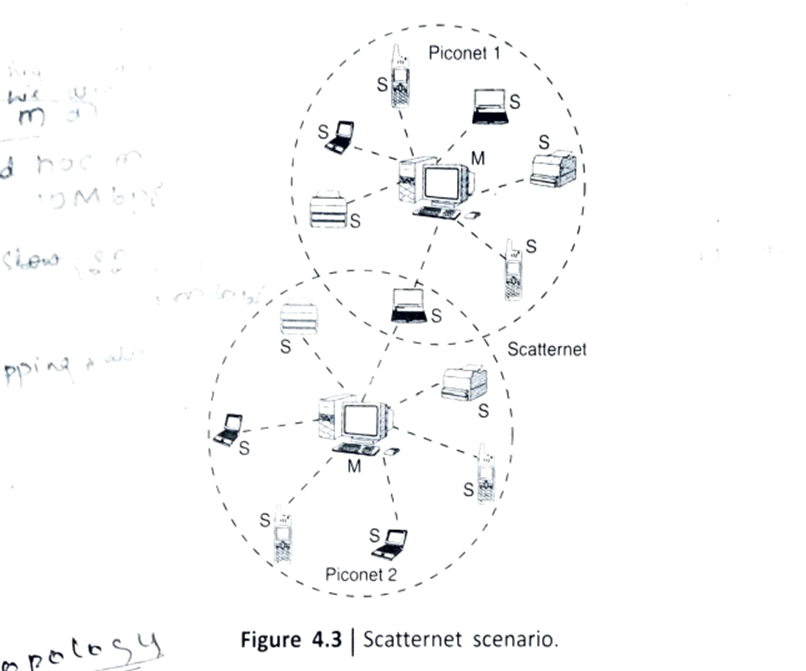
Piconet- A piconet is a WPAN formed by a device serving as a master and a one or more devices serving as slaves in the network.As the enabled devices come withing range, a master is elected by establishing the connection with the other devices setting the frequency-hopping sequence and the system clock to determine the phase.
The master is a device in a piconet whose clock and device addresses are used to define the characterstics of the piconet physical channel.All other devices in the piconet are called piconet slaves.At any given time data can be transferred between the master and any one slave.
The master switches rapidly from salve to slave in a round robin fashion. ANy device may switch the master slave role at any time. Slaves communicate only with their master in a point to point fashion under the controlof the master.
Scatternet: A scatternet is a collection of operational piconets overlapping in time and space. A device that is a member of two or more piconets is said to be involved in a scatternet. Involvement in a scatternet does not necessarily imply and network routing capability or function in the device.
The scenario for the scatternet is shown in fig where two piconets are connected through a common slave. A device may participate in several piconets at the sametime, thus allowing for the possibility that information could flow beyond the coverage area of the single piconet.
A device in a scatternet could be a slave in several piconets,but master in only one of them.The perfomance of a WPAN highly depends on scaternet structure
Bluetooth
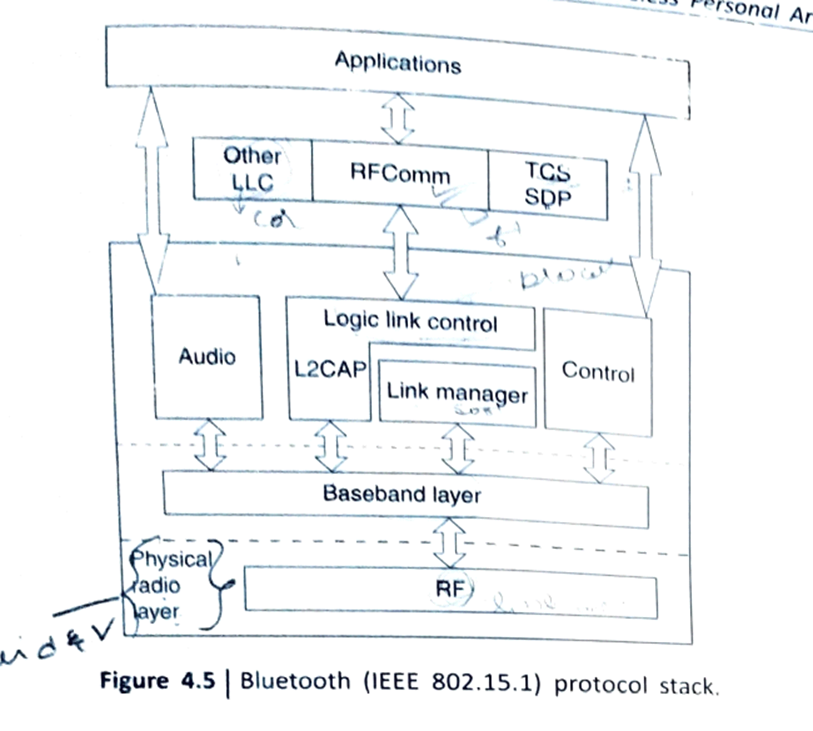
IEEE 802.15.1 is a WPAN standard based on the Bluetooth v1.1 specification which is a short range radio technology operating in the unlicensed 2.4 GHz industrial, scientific and medical (ISM) frequency band. The original goal of Bluetooth was to replace the cables but now this technology is used to interconnect various Blyetooth devices and aciliate more ways of exchanging data.
Protocol stack arrangement is sown in fig and the definitions of the protocol used in bluetooth stack are as follows:
1. Physical radio later (radio frequency, RF) receives and transmits data and voice
2. Baseband layer enables the physical RF link between Bluetooth units that form a piconet
3. Link manager is the protocol that handles lie establishement between bluetooth devies which include authentication and encryption
4. Logical link control and adaption protocol (L2CAP) is a lower connection based bluetooth communication protocol that implemets multiplexing. L2CAP does not implement flow control.
5. The audio profile is responsible for managing connections for sending/ receiving control data to/from audio devices and for encoding/decoding audio data and sending/ receiving it to/from the headset
6. The control block processes various operations for connectivity management of devices.
7.Other logic link control(LLC) profiles that are optional in devices are cordless telephony intercom headset dial up network,fax, local area netwrok (LAN), file transfer and synchronoization
8.Radio frequency communication(RFComm, serial cable emulation protocol) serves as a base for COM port emulation facilities and derived point to point protocol
9. Telephony control specification(TCS) is a bit orientaed protocol that defines the call control signalling for the establishement of speech and data calls between Bluettoth devices
10. Service discovery protocol (SDP) is a Bluetooth service discovery protocol that handles publishing and discovery of services running on top of the Bluetooth stack
11. Application profile supports audio applications, network applications, telephony service applications and management applications
ZigBee
ZigBee is a Personal Area Network task group with low rate task group 4. It is a technology of home networking. ZigBee is a technological standard created for controlling and sensor the network. As we know that ZigBee is the Personal Area network of task group 4 so it is based on IEEE 802.14.4 and is created by Zigbee Alliance.
Topologies-
STAR TOPOLOGY
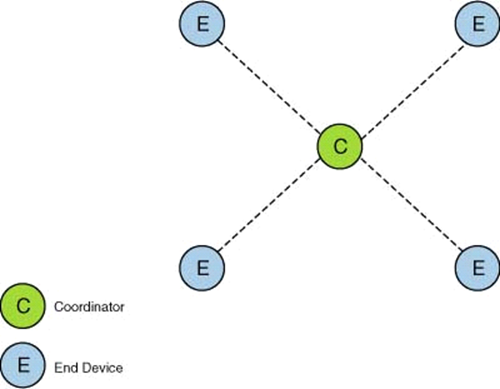
The first topology is the star topology. Star topology consist of a coordinator and few end devices. It is the simplest and most limited one in the Zigbee. Devices are all connect to single coordinator node and all communication goes via this coordinator. The interesting part about the star topology is it actually define by the underlying 802.15.4 specification which Zigbee builds on. The disadvantage of this topology is it may become hindrance and there is no option path from the source to the end devices.
Tree Topology
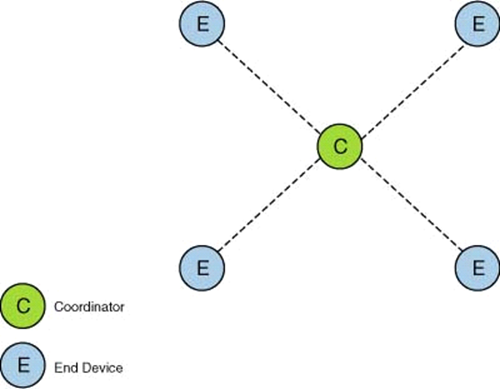
The second topology is tree topology. It consists of coordinator, few routers and end devices that act as a central node or root tree. The routers operate as a extension for the network coverage. The end nodes that connected to the parent (coordinators or routers) are called children. Only the end devices can communicate with the parent. The detriment of the tree topology is if one parent is disable, the children of the disable parent cannot communicate with other devices in the network even they are close to each other.
Mesh Topology
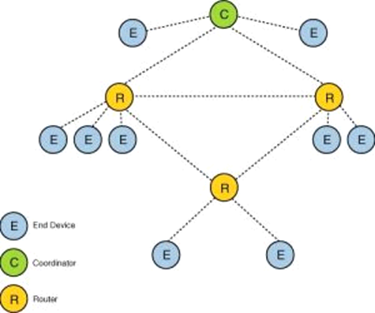
The third and last topology is peer-to-peer or mesh topology. This topology consists of a coordinator, a few routers and an end devices. You can expand the network range by adding more devices into the network. If during the transmission one of the path is fail, the node will find the alternate path to reach to the destination therefore eliminating dead zones. Using this mesh topology it is easier for user to add or remove the device because they can communicate with any destination device in the network.
Zigbee stack architecture-
The ZigBee stack is founded over the IEEE 8.2.15.4 standard which defines the multiply accumulate MAC and PHY layers of the protocol. Fig illustrates the zigbee stack architecture
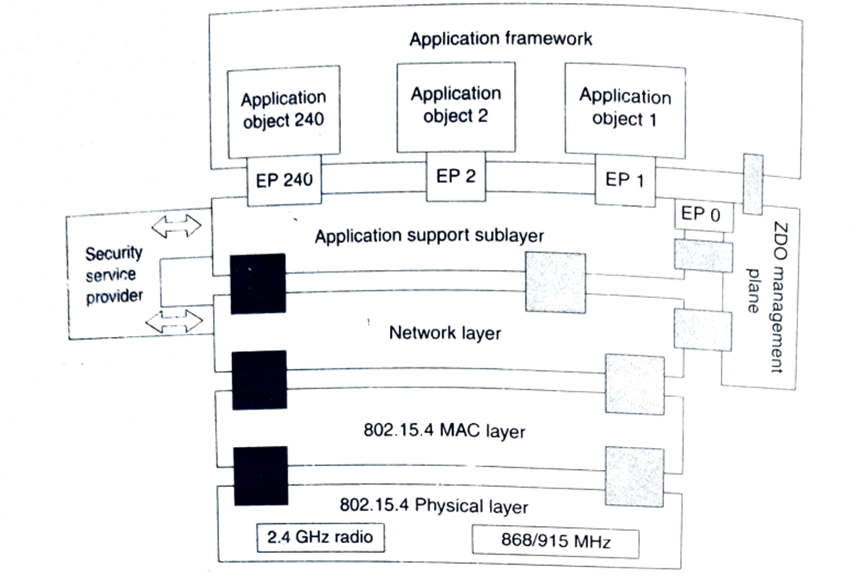
The different layers of the zigbee stack communicate with each other using service access points (SAPs). Most laters of the zigbee stack defin data and mangement entitity interfaces
1. Phyical layer: The PHY layer defines radio characterstics and suppprts the 2.45 Ghz and 868/915 Mhz radio bands. IEEE 802.15.4 employs DSSS on PHY layer and it is operated in three frequency bands. OF a total 27 channels acroos these three bands,16 channels are available in the 2.4 GHz band with 250 kbs maximum data throughput 10 channels in the 915 Mhz band with 40 kbps maximium data throughput and 1 channel in the 915 Mhz band with 40 kbps maximum data throughput and channels in the 868Mhz band with 20 kbps maximum data throughput.
2.MAC layer: MAC layer uses carrier sense multiple acces with collision avoidance. IEEE 8.2.15.4 MAC defines four frame structures:
-A beacon frame that is used by a coordinator to transmit beacons
-A data frame that is used for all transfers of data
- An acknowledgment frame that is used fo confirming successful frame recemption
- A MAC command frame that is used for handling all AMC peer entity control transfers
3. Network layer: Network layer handles network address and routing by invoking actions in the MAC layer. Its tasks include starting the network(coordinator), assigning network addresses adding and removing network devices, routing messages, applying security and implementing route discovery
4. Apllication layer: The top layer in the ZigBee protocol stack consits of the application framework, Zigbee device object(ZDO) and application support(APS) sublayer
-Application framework provides a descriptionof how to build a profile onto the ZigBee stack. It also specifies a range of standard data tyoes for profiles, descriptors to assist in service discovery,frame formats for transporting data.
-Application object is a software at an endpoint that controls the ZigBee device.
-ZDO management plane facilitates comunication between the APS and network layers with the ZDO
-APS sublayer is responsible for providing a data service to the application and ZDP's
-Security service provider(SSP) provides security mehanisms for layers that use encryption[network (NWK) and APS]. These security mechanisims of SSP are initalized and configured through the ZDO.
WPAN Applications
Automotive: The use of WPAN is most suitable for vehicles as the distances between devices within the vehicles will be limited to an acceptable range and the use of cables to connect devices is cumbersome
Information sharing: IEE802.15 devices have been developed for workplace use with file sharing,printing and multimedia communications.
Home automation: The interconnectivity within the home with an increase in digitally based devices will make data transfer much more prominent
Office automation: Notebook,printer, PDA, desktop computer fax machine mouse keyboard- all can be instantly connected via bluetooth technology. Stay completely up-to-date,any where and any time.
RFID applications: Some o the RFID applications using WPAN technologies find applications in asset tracking, people tracking,inventory tracking etc.


